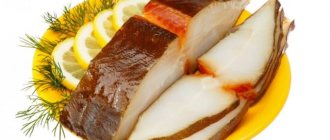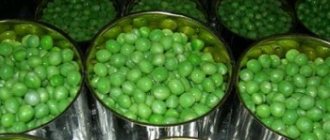Composition of canned tuna in its own juice
The amount of protein in the meat of a sea predator is the largest compared to individuals of other species.
The composition of fish cooked in its own juice is presented in the following table:
| Minerals per 100 g of product | Quantity |
| Nickel | 6.0 mcg |
| Calcium | 24.0 mg |
| Sulfur | 225.0 mg |
| Phosphorus | 228.0 mg |
| Molybdenum | 4.0 mcg |
| Chlorine | 55.0 mcg |
| Iron | 1.2 mg |
| Magnesium | 24.0 mg |
| Fluorine | 430.0 mcg |
| Potassium | 296.0 mg |
| Chromium | 55.0 mcg |
| Zinc | 0.7 mg |
| Sodium | 960.0 mg |
| Vitamins, weight 100 g | |
| PP | 9.80 mg |
| E(TO) | 0.20 mg |
| B1 | 0.05 mg |
| B2 | 0.15 mg |
The amount of protein in tuna meat reaches 30%. This easily digestible and complete substance, containing 8 rare amino acids, is an indispensable component of nutrition not only for adults, but also for children.
Composition of canned food in oil
The content of vitamins and minerals in tuna cooked in oil is somewhat different from canned tuna in its own juice.
| Minerals per 100 g of product | Quantity |
| Sulfur | 220.0 mg |
| Calcium | 25.0 mg |
| Phosphorus | 238.0 mg |
| Magnesium | 25.0 mg |
| Nickel | 6.0 mcg |
| Zinc | 0.7 mg |
| Chlorine | 165.0 mg |
| Molybdenum | 4.0 mcg |
| Iron | 0.8 mg |
| Potassium | 298.0 mg |
| Fluorine | 430.0 mcg |
| Chromium | 55.0 mcg |
| Vitamins | |
| PP | 13.20 mg |
| E(TE) | 6.10 mg |
| B1 | 0.04 mg |
| B2 | 0.12 mg |
In addition to adding fat, canned food contains additional components that provide a piquant taste to the prepared dish.
Half is overboard
GOST 7452-97 clearly lists the organoleptic indicators that canned fish, including tuna, must meet. Here they are:
The taste is pleasant, characteristic of canned food of this type, without any foreign taste.
The smell is pleasant, characteristic of canned food of this type, without any foreign odor.
The consistency of fish meat is tender, juicy or dense. Perhaps a bit dry.
The consistency of the bones and fins is soft.
Condition of the fish – the pieces of fish are whole and do not fall apart when put out of the jar. The cross section of the pieces is smooth.
The state of the broth - with or without the presence of fat on the surface. There may be suspended particles of protein, skin and fish crumbs.
The color of fish meat is characteristic of boiled meat of this type of fish.
The color of the broth is light.
The transparency of the broth is clear.
The presence of scales has been removed. It is possible to leave scales on salmon fish.
Laying order - pieces of fish are tightly laid with a transverse cut to the bottom and lid of the jar. The height of the pieces should be equal to the internal height of the jar or 4–5 mm below it.
The presence of foreign impurities is not allowed
As it turned out during laboratory tests, three out of six test participants did not meet the requirements of the standard.
Fish House tuna tasted sour to experts. Samples of "John West" and "Skipjack" (trademark "Fish Gallery") did not stand up to criticism for taste, smell and consistency. They have a taste and smell that is unusual for this type of canned food, as well as a crumbly consistency and cloudy color of the broth.
All six participants in the test are canned food in their own juice, which contains only fish, water and salt. One sample - "Skipjack" (trademark "Fish Gallery") - is declared as tuna for salads. However, such a standard does not exist in Russia. Perhaps this is an advertising ploy by the manufacturer, allowing him to sell production waste - finely chopped meat, more reminiscent of porridge.
test conclusions
Safety testing showed that none of the samples contained microorganisms that could cause food poisoning.
The content of histamine, which can also lead to food poisoning and allergies, was significantly below the maximum permissible value in all tested canned tuna.
But in terms of organoleptic indicators, three out of six test participants do not meet the requirements of the standard. Fish House tuna tasted sour, while samples of John West and Skipjack (Fish Gallery brand) drew criticism from experts regarding taste, smell and consistency.
According to the results of the tasting, canned tuna of the Russian brand “Bars” received the highest score for taste, with a significant gap from the other participants in the test.
Calories in canned tuna with and without oil
The energy value of the product is important for the correct calculation of the daily diet. This indicator depends on the variety of the individual, the method of canning, as well as the ingredients added by the manufacturer to the food. The table provides a detailed calculation of the calorie content of fish in oil and in its own juice.
| Tuna in its own juice | Per 100 g of product | In 1 tbsp. l. | In 1 tsp. |
| Proteins, g | 21,0 | 5,2 | 1,5 |
| Fats, g | 21,0 | 0,3 | 0,1 |
| Carbohydrates, g | 0,0 | 0,0 | 0,0 |
| Calorie content, kcal | 96 | 24 | 6,7 |
| Tuna in oil | |||
| Proteins, g | 29,1 | 7,3 | 2,0 |
| Fats, g | 8,2 | 2,0 | 0,6 |
| Carbohydrates, g | 0,0 | 0,0 | 0,0 |
| Calorie content | 197,9 | 49,5 | 13,8 |
tuna in its own juice is a less calorie dish compared to its counterpart with oil. The second option is more satisfying, but not entirely suitable for dietary nutrition. In any case, in order not to cause harm to health, this product should be consumed in limited quantities.
Benefits of canned tuna
Canned tuna (the benefits of the prepared product depend on the components included in the dish) has a characteristic feature characteristic of this type of fish - after heat treatment, its meat retains the entire complex of useful substances.
Regular consumption of such food is manifested by the following positive effects on the human body:
- improves brain activity and memory, activates mental activity;
- normalizes blood pressure, reduces the level of “bad” cholesterol in the blood;
Canned tuna helps normalize blood pressure and lower blood cholesterol. - is the prevention of diseases of the cardiovascular system, prevents the occurrence and development of atherosclerosis;
- has antitumor and anti-inflammatory effects, improves immunity;
- helps in removing toxins and other harmful substances from the body, normalizes metabolic processes;
- strengthens the skeletal system, teeth, promotes the growth of muscle fibers;
- actively fights depression and other neurotic conditions, improves mood.
The tuna diet is a real godsend for women. Eating fish meat (fresh or canned) provides better blood supply to skin cells. The presence of B vitamins in the product, especially folic acid, as well as the Omega-3 fat complex, allows you to moisturize the skin and even smooth out fine wrinkles.
To maintain health
The high fat content does not prevent tuna from remaining on the list of the most healthy dietary foods. It is no coincidence that this species of underwater inhabitants is the most popular in the diet of the Japanese, known in the world for long-livers.
Tuna meat is rich in vitamins, macro- and microelements. The presence of selenium in fish meat is important to maintain overall health. This valuable mineral protects the body from cancer, heart disease, and other serious illnesses that become frequent causes of death.
Equally important is the body’s ability to adapt to any changes in the internal and external environment. Maintaining the process of homeostasis (self-regulation) involves acids that belong to the Omega-3 group. It is their large amount in tuna meat that allows a person to feel comfortable and comfortable, to be healthy and full of strength in any situations that arise.
For a strong heart
Research by scientists has shown that eating 30 grams of tuna meat daily reduces the risk of cardiovascular disease. This effect is ensured by the presence in the product of the same valuable polyunsaturated fatty acids - Omega-3 and also number 6. These components prevent one of the main causes of heart disease - the development of atherosclerosis.
Regular consumption of fish can reduce the content of low-density lipoproteins in the blood, as well as triglycerides, which contribute to the formation of atherosclerotic plaques.
According to scientists, eating tuna can replace many pharmaceutical drugs prescribed for diseases such as arrhythmia, cholecystitis or thrombophlebitis. Systematic inclusion of the product in the menu will ensure the health of the heart and the entire circulatory system and prolong a person’s life.
To improve vision
The beneficial components of tuna have a beneficial effect on all human systems and organs, including vision. Vitamin A (retinol) removes fatigue and tension from the eyes, making the picture as clear and precise as possible. Moderate consumption of tuna meat has a positive effect on the visual system, prevents the development of glaucoma, as well as macular degeneration, and protects the retina from drying out.
For cancer prevention
Canned tuna, the benefits of which are evident in the treatment of cancer, is often included in the regular diet of patients. Scientific research has established the healing properties of tuna meat, which prevent the development of cancer of the breast, ovaries, oral cavity, digestive organs, and pancreatic cancer.
The occurrence of tumors is resisted by calciferol in the product, as well as fatty acids that have an antioxidant effect. Both fresh fish and canned tuna have preventive capabilities, destroying free radicals and toxins in the body. To prevent malignant tumors, it is necessary to regularly consume fish meat.
For the brain
Tuna is unique not only for its gigantic size, but also for its whole complex of useful substances, which include polyunsaturated fatty acids. The unique properties of these valuable substances have a positive effect on the cognitive functions of the brain, which are responsible for performing a huge number of physical tasks.
Using tuna in the diet helps prevent Alzheimer's disease.
Fish meat prevents memory loss, normalizes blood supply to the brain, stimulates its work, supports nerve impulses, and reduces the risk of inflammatory processes.
Natural antidepressant
Eating tuna is especially beneficial for people prone to depression. Fatty acids have a positive effect on a person’s mental health, reduce fatigue, and improve mood. B vitamins help cope with melancholy. Treatment with an appetizing product is much more pleasant and beneficial than using chemicals.
Tasty therapy provides a faster way out of a depressed state. The serotonin produced increases muscle tone and improves self-control. Eating a portion of tuna gives physical pleasure, but the positive emotions received will bring a feeling of satisfaction and joy.
The benefits of fish for immunity
Acids belonging to the omega-3 group are involved in maintaining homeostasis and take part in ensuring an adequate immune response during inflammation. The vitamins contained in canned tuna are necessary not only to strengthen the immune system in general, but also to ensure tissue regeneration processes.
Unsaturated fats and many microelements, such as selenium and zinc, have antioxidant properties, protecting the body's cells from harmful chemicals. That is why their presence in the diet will help prevent premature cell death and aging of the body.
Harmful qualities of canned food
Eating tuna, like any other product, has not only positive effects on the body, but also harmful effects.
The disadvantages of the product include:
- the ability to accumulate toxic substances that enter the fish’s body through blood vessels and skin. Eating contaminated meat can result in problems with memory, vestibular system, speech and hearing;
- Canned food with a high sodium content can cause just as much harm. A fish dish with too much salt has this negative feature. Food prepared with a high content of this component can lead to fluid retention in the intercellular space and increased blood pressure.
To minimize the possible negative consequences of eating fish, you need to limit the size of portions and remember that the product canned in its own juice will bring more benefits.
Harmful bisphenol A
This chemical substance, first synthesized in the last century by the Russian scientist A.P. Dianin, is an analogue of the female hormone estrogen. The entry of this substance into the human body can have dangerous consequences for his health and negatively affect his offspring.
The presence of biphenol-A in the body can lead to genetic damage to DNA, the development of cancer, and type II diabetes.
The reason for the presence of a harmful chemical compound in a valuable product was the so-called plastic pollution of the marine environment. The chemical element released from plastic accumulates in the organisms of the inhabitants of the underwater depths. There is no need to exclude fish from your diet if you consume it in limited quantities.
Harm from mercury in tuna meat
The presence of heavy metal is observed in almost all seafood. The level of mercury in fish meat is individual, so the presence of a dangerous component may not always provoke harmful consequences for the body.
Symptoms of toxic poisoning:
- nasal congestion;
- skin rashes;
- swelling of the larynx;
- dizziness, loss of consciousness.
If these symptoms occur, you should immediately seek medical help. However, the presence of a minimum amount of lead is not a reason to completely refuse to include tuna in the menu if the benefits of the fish outweigh the likely damage to health.
What are the benefits of canned tuna?
Of course, gourmets appreciate the taste of chilled tuna fillets. Amazing dishes are prepared from this type of fish both for every day and for the holiday table. Believe me, you can also create a gastronomic masterpiece from canned fish. Cook a fragrant soup or make an incredibly tasty snack.
So, nutritionists advise eating tuna at least once a week. How is this fish useful for the human body? The chemical composition of red fish fillets is impressive. The healing properties of canned tuna include:
- prevention of cardiovascular pathologies;
- breakdown of bad cholesterol;
- preventing the formation of plaques;
- cleansing of vascular lumens;
- normalization of blood circulation;
- activation of brain activity;
- treatment of dermatological ailments, including allergic ones;
- improvement of well-being in diabetes mellitus;
- suppression of the activity of radical compounds;
- prevention of the appearance of malignant neoplasms;
- increased mood;
- strengthening the nervous system;
- improvement of well-being in case of depression and neurotic disorders;
- cleansing liver cells of toxins;
- promoting the full production of liver enzymes;
- strengthening nail plates and curls;
- improving the condition of the skin;
- strengthening bone tissue;
- lowering blood pressure levels.
As you can see, the list of beneficial properties of canned tuna is pleasantly surprising. Still, this list cannot be called exhaustive. Thus, after conducting research, scientists came to the conclusion that tuna fillet has a beneficial effect on the functioning of the brain, so this product is recommended to be included in the diet of people engaged in daily mental work.
A variety of vitamins, micro- and macroelements, as well as fatty acids help strengthen the hair structure, nail plates and give the skin a healthy, radiant appearance.
In addition, canned tuna fillet is enriched with retinol. With vitamin A deficiency, vision impairment and decreased immunity are observed. To slow down the processes of premature aging and strengthen the immune system, you just need to systematically eat tuna fillet.
Many people today are trying to adjust their diet and gradually give up unhealthy foods. Instead, healthy natural foods appear on the menu. If you want to make up for protein deficiency, get gastronomic pleasure and satisfy your hunger, eat tuna fillet canned in its own juice.
On a note! The low nutritional value of tuna in this form allows you to eat fish while on a diet. There are no carbohydrates in tuna, but protein accounts for almost a quarter of the total mass. Tuna is very often found in the diet of athletes.
Another interesting fact. There are no helminthic infestations or other parasites in tuna fillets, since the fish are not susceptible to such infection. Accordingly, you can not worry and calmly introduce tuna fillet into your daily diet.
Is it possible and how to properly consume canned tuna?
Tuna, properly canned industrially or at home, brings great benefits to the body. The finished product is easily absorbed by the body and does not cause a feeling of discomfort or heaviness in the stomach. It should be taken into account that canned food without oil and other additional components (vegetables, tomatoes) have these indicators.
The food should contain only salt and spices. As you might guess, we are talking about tuna in its own juice. Harmful preservatives that ensure food shelf life are rarely added by manufacturers, since these goals are achieved by high temperatures during the cooking process.
At the same time, the content of phosphorus, potassium and calcium in the product remains unchanged, but vitamins are practically destroyed. Fruits and vegetables will help compensate for the lack of important components, which should definitely be included in the diet, including as a source of fiber.
Thus, if you take into account the peculiarities of the composition of canned tuna, consuming them in limited quantities is not only possible, but also useful without fear for your health and slim figure.
For weight loss and dieting
The secret to the effectiveness of quickly losing excess weight on the tuna diet lies in the same low calorie content of the product. Fats contained in small volumes (0.8% per 100 g) are unsaturated, and therefore beneficial for the body, components.
The presence of a large amount of protein (28%/100 g) ensures that fat is “processed” in the direction necessary for the body, so folds on the sides and abdomen not only will not appear, but will also become significantly smaller.
This result is possible by joining a daily exercise program (gym or 30-minute exercise). While on a diet or fasting program, you should definitely eat a large amount of vegetables and fruits. Tuna goes great with them. It is recommended to eat at least 5-6 times a day. Do not forget about drinking water - up to 2 liters per day.
During pregnancy
Canned tuna (the benefits of the product for a woman’s body are beyond doubt) is not recommended for use by expectant mothers. The reason for this was the accumulation of toxic metal in the product.
Excessive mercury content can cause intoxication, manifest as nervous and other diseases, and harm the body of the fetus and mother. If you notice the first adverse symptoms (dizziness, laryngeal swelling, nasal congestion), you should stop taking the product and consult a doctor.
When breastfeeding
You need to be especially careful when using canned or fresh tuna during lactation. Dangerous substances that get into fish meat enter the child’s body with mother’s milk. This can cause severe disruptions in the functioning of the baby’s internal organs and brain. When buying a jar of delicacy, you need to pay attention to the expiration date, cooking method, and quality of the fish.
For pancreatitis and gastritis
Nutritionists recommend that people with pathologies of the pancreas and gastrointestinal tract include canned tuna in their regular diet.
The small presence of fats and carbohydrates in the product with a significant protein content makes the food healthy and at the same time medicinal. Omega acids can reduce the amount of cholesterol, while natural regulation of metabolic processes occurs in cells.
For gout
A feature of this disease is disruption in the body during the excretion of uric acid (sodium monourate). The formation of its increased concentration in the blood serum leads to the development of inflammatory processes in the joints.
When fighting a serious illness, nutritional culture plays an important role: excluding from the menu foods with an excess of simple carbohydrates, alcohol, sweet drinks, and other undesirable components.
The diet should include foods with a moderate purine content - up to 400 mg per 100 g, limit the consumption of products with a substance range from 100 to 400 mg. An ideal nutritional component would be canned tuna, which contains 290 mg of purine.
Interesting features of tuna:
- This fish is a record holder for protein content: up to 24%;
- Tuna reaches speeds of up to 75 km/h, so it contains much less fat than other varieties. Ideal for athletes and weight watchers;
- Calorie content of fresh or canned tuna is only 120 kcal/100 g;
- The red color of the fish is due to the high hemoglobin content;
- Tuna is a storehouse of vitamins B12 and B6, essential for the proper functioning of the nervous system. It is recommended to include it in the daily diet during increased mental stress;
- The fish is not infected with parasites, so it is safe to eat raw;
- It also contains a large amount of omega fatty acids, vitamins A, D and E, iron, calcium and phosphorus, selenium and other vitamins and minerals.
Types of tuna and their characteristics, choosing the best type of fish
In nature, there are over 50 subspecies of this “fast” predator, reaching a length of 50 cm to 4 m and a weight of 2 to 600 kg.
The genus of schooling mackerel fish is divided into 8 species:
| Name | Description |
| Auxis Thazard (mackerel tuna) | This small (up to 40 cm long) representative of the mackerel has a silver-blue color with wavy lines on the sides, a large fin and a white belly. It spawns all year round and can be cooked in any way - frying, baking, stewing. |
| Thunnus thynnus (common or bluefin) or Bluefin tuna | The individual is bluish-black with silver stripes. Reaches a length of more than 4 m. Weighs up to 800 kg. Used for sashimi, steaks, and other dishes. |
| T.alalunga (Longfin or White) | It grows more than 1 m, weight - up to 45 kg. The back is dark blue, the belly is silver-white. Often used for canning. |
| Katsuwonus pelamis (Skipjack or Bonito) | It reaches 90 cm in length and weighs up to 23 kg. Mostly used dried or smoked, suitable for Japanese soup (dashi). |
| T. obesus (Big Eyed) | Similar to its yellowfin counterpart, but differs in its large eyes. Capable of growing up to 2 meters or more, weighing up to 200 kg. Used fried or otherwise. |
| T.maccoyii (Bluefin, Bluefin or Australian) | Occupies an average position among other tuna. It grows up to 2.5 m, weight reaches 260 kg. |
| T. atianticus (Small Atlantic) | The length of the individual is up to 120 cm, it has bright red, not very fatty meat, which is often used for preparing canned food. |
| T.aibacares (Yellowfin) | The fish is yellowish in color and has blue stripes on each side. Weighs up to 180 kg. The most popular commercial species, which produces delicious dishes - grilled, stewed with vegetables in wine. |
The choice of tuna variety depends on the dish for which the product is intended. It is always worth remembering that this is a very fatty fish, so it should be used for food in the freshest possible condition. When inspecting the carcass, you need to pay attention to the fillet - it should be dense and firm, red or dark red in color, and have a meaty aroma without any foreign impurities.
The best varieties are recognized as: Longfin tuna, Albacore, Yellowfin. No less popular is the Atlantic bonito (Bonito), which is also classified as tuna and mackerel (something in between these species).
Technology for preparing canned food at home
Getting a delicious dish from such a delicious product is not very difficult, but it will take some time (up to 4 hours). Buying high-quality fish is also not difficult, so you can immediately begin the cooking process.
Ingredients:
- vegetable oil - 400 ml;
- peppercorns, laurel leaves - 20 pcs.;
- tuna carcasses - 2 pcs.;
- coarse salt - 2 tbsp. l.
Step-by-step preparation:
- Take out frozen fish in advance, thaw it in natural conditions, and then remove the fins and entrails. Rinse the carcasses thoroughly, dry with paper towels, and cut into small pieces.
- Line a deep bowl with parchment and place the paper crosswise. Send spices, salt, bay leaves into the resulting “container”, pour in fresh oil, and parts of fish.
- Connect the ends of the parchment at the top with a knot, secure the gathered edges, and place in a baking sleeve.
- Place it in the boiling liquid so that the packaging does not touch the bottom of the container. Cook the fish over low heat for up to 4 hours, adding liquid as it evaporates.
- Take out the package, place it on a plate, unwrap the paper, and cool the food.
During the cooking process, the fish is cooked in its own juices and oil. Using the same method you can get a dish without adding fat.
Rules and criteria for choosing ready-made canned tuna
It is better to purchase fish products in large supermarkets, where quality control of such products is carried out.
When purchasing canned tuna, consider the following criteria:
- pay attention to the packaging - a tin can. It should be free from mechanical damage, drips and stains, rust and nicks. Any violation of integrity entails loss of tightness and damage to the product;
- It is advisable to choose a delicacy sealed in a new type of tin container. The markings on it will be extruded from the inside or outside. The modern version of product identification, which has replaced paper labels, is more difficult to counterfeit;
- inspect all letters, numbers and signs to ensure that there are no changes in the data provided by the manufacturer;
- The main sign of the quality of canned food is weight. The jar should indicate the total weight and the weight of the fish itself. You should make sure that the posted information complies with GOST 7452097, and also check the presence of the product barcode - “OTN”. If it is not on the container, there is reason to doubt the contents of the canned food;
- As a rule, the manufacturer indicates an expiration date of 3 g on the jar. It is advisable to buy a product produced up to 2 months. back. A product that is stale will lose its beneficial ingredients and will lose the exquisite taste characteristic of the delicacy.
When purchasing canned tuna, you need to keep in mind that the best dish contains only 3 components - the fish itself, salt and water.
Safety first
The study of canned tuna was carried out for compliance with GOST 7452-97 “Natural canned fish. Technical conditions". This standard establishes requirements for product safety, organoleptics (taste, smell, color), labeling, storage conditions, etc. Microbiological indicators were checked according to GOST 30425-97 “Canned food. Method for determining industrial sterility."
The research began with the most important thing - safety testing. First of all, it was necessary to find out whether the fish contained microorganisms that could cause food poisoning.
From this point of view, all samples turned out to be excellent.
But to be completely sure whether the tuna in the jar is safe or not, you still need to examine it for histamine content. If the amount of this substance is tens of times higher than the maximum permissible norm (100 mg/kg), the fish acquires a pungent taste, and the person who eats it can be poisoned, seriously, even to the point of death. Symptoms of poisoning usually include headache, nausea, changes in blood pressure, and rapid heartbeat. Histamine is formed under the influence of bacteria from the amino acid histidine, and it is found in tuna, mackerel, horse mackerel and some other fish.
Histamine levels increase during long-term storage of canned fish. Histamine is also present in the human body, but in an inactive or bound form.
In our case, in all tested canned food, the histamine level was almost two times lower than the permitted “ceiling”: from 57.8 for “FishHouse” to 53.7 for the “Skipjack” sample (trademark “Fish Gallery”).
What can you cook with tuna? Step-by-step recipes
Canned tuna, the benefits of which are always taken into account in nutrition, is most often present in a variety of salads. This preference is explained by the complete absence of bones in the product and the good compatibility of the pulp with fresh, stewed or boiled vegetables. Soups, casseroles, sushi, other cold and hot dishes, pizzas and pastas are no less in demand.
Tuna and avocado salad
Grocery list:
- sunflower oil - 2 tbsp. l.;
- lemon - 1 pc.;
- fish in its own juice - 2 cans;
- tomatoes - 2 pcs.;
- eggs - 2 pcs.;
- avocado - 2 pcs.;
- red onion - 1 pc.;
- garlic cloves - 2 pcs.;
- salt, regular sugar - 5 g each;
- greens - to taste.
Preparation procedure:
- Boil the eggs, cool, remove the shells, and chop into cubes.
- Peel the avocado and onion, cut into small pieces. Arrange the tomatoes in the same form and chop the garlic.
- Combine processed foods in a serving bowl. Add tuna fillet and chopped greens.
- Sprinkle the salad with lemon juice, season with salt, sugar and butter.
Mix the mixture and serve the salad.
Tuna soup
List of components:
- sunflower oil - 30 ml;
- onion, carrot, tomato - 1 pc.;
- can of tuna;
- rice - 60 g;
- drinking water - 2 l;
- a pinch of regular sugar;
- salt, herbs - according to preference.
Cooking order:
- Remove the skins from the potatoes, rinse, and cut into small cubes.
- Place the tuber pieces in a saucepan, add filtered water, and heat the mixture to a boil. Cook the product for 10 minutes.
- Peel the carrots and onions, chop into cubes, fry in oil until soft. Add chopped tomato, pepper, salt and sugar. Simmer for 5 minutes.
- Add vegetables and well-washed rice to the container with potatoes, continue the process for another 10 minutes, then add pieces of canned fish. Finish cooking after 5 minutes.
Serve the soup to the table, sprinkle with chopped herbs.
Tuna casserole
Product set:
- sunflower oil;
- whole milk - 200 ml;
- canned tuna - 400 g;
- rice - 400 g;
- cherry tomatoes - 15 pcs.;
- Mozzarella cheese - 200 g;
- eggs - 4 pcs.;
- onion feather - 1 bunch;
- salt, pepper - to taste.
Cooking sequence:
- Boil the rice until ready in salted water, drain in a colander.
- Mash the tuna meat without broth with a fork and combine with the cereal.
- Spray the baking dish with oil and add the rice and fish mixture.
- Place small tomatoes and chopped onions on top.
- Grate the cheese, mix half the chips with eggs and milk, add salt and pepper to the mixture, and pour it over the rice layer. Leave the container for 20 minutes. into an oven heated to 180°C.
- In 10 min. Before the end of cooking, sprinkle the workpiece with the remaining cheese.
Serve the casserole hot.
Simple tuna pie
Required components:
- butter;
- yeast dough - 600 g;
- onion - 1 pc.;
- canned tuna - 300 g;
- potatoes - 5 pcs.;
- salt, pepper - to taste.
Cooking technology:
- Peel the tubers, rinse, cut into strips. Add finely chopped onion.
- Drain the tuna and mash the flesh with a fork.
- Divide the finished dough into 2 pieces.
- Roll out a large part, transfer the layer to a baking sheet dusted with flour, and form sides.
- Place the potato and onion mixture on the sheet of dough and smooth out the mixture. Place the mashed fish on top and scatter pieces of butter over it.
- Cover the food with the second crumpet, pinch the edges in the shape of a pigtail.
- Prick the top layer in several places with a fork and brush with beaten egg.
- Bake the product for 40 minutes. at a temperature of 180 °C.
Remove the pie from the oven, brush with oil and cover with a towel. Leave the baked goods in this form for a quarter of an hour.
There is only one Russian
Of course, it is best to eat freshly caught fish, as the Japanese do, but since it is not easy to find it on sale here, you often have to be content with canned fish. Lately people have been buying them with particular interest to prepare tuna salads and other dishes. But what is the quality of these products?
We purchased 6 cans of canned tuna from different manufacturers in stores and sent it to the laboratory for testing.
Our “nets” included tuna from the following brands: “Fish Gallery”, “Fish House”, “Fortuna”, “John West”, “Shturval” and “Bars”®. Almost all test participants “sailed” from abroad: the first three were made in Thailand, “John West” in the Seychelles, “Shturval” in China, and only the sample with the completely “unfishy” name “Bars” was made in Russia. It was all the more interesting to compare the quality of imported and domestic canned food.
All results and conclusions presented in the article refer only to the studied samples.
Storing canned tuna
The technology for manufacturing canned tuna ensures good external processing of the cans, which allows the product to be stored unopened for up to 3 years. You can find out more about the expiration dates of food from the information on the container itself. At home, canned tuna is best kept in a cool, dark place.
Opened canned food should be consumed immediately or transferred to a glass container and stored tightly closed in the refrigerator for no more than a day. Deliciously cooked tuna is an excellent canned product, the benefits of which are inherent in nature itself.
Eating fish at least 2 times a week will allow you to enjoy the taste of the delicacy and provide the body with a valuable complex of substances necessary for health.
Article design: Oleg Lozinsky











